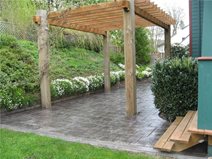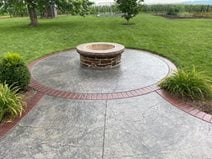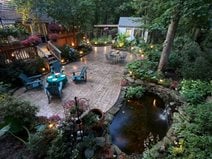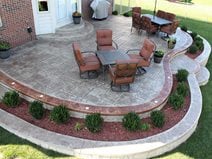Whether you’re installing a new decorative concrete patio or upgrading an existing one, surrounding it with a border is a great way to elevate its appearance. Patio borders can serve a number of purposes. In addition to giving your patio more personality, they can also be used to define boundaries, create privacy, prevent erosion, and provide a natural transition to the rest of your outdoor living space.
Find concrete patio contractors near me.
When it comes to design options available for concrete patio borders, the choices are endless, allowing you to create a custom look that suits your budget, style, and available space. Here are 12 ideas for patio borders to help spark your imagination.

AMCON, LLC in Gaithersburg, MD
1. Use Contrasting Colors
One of the simplest techniques for defining concrete borders is to use a color that contrasts with the rest of the patio. This stamped concrete patio uses lighter-colored bands around the perimeter as well as several bands extending across the slab to define various zones for entertaining and relaxation. If you prefer more subtle contrast, try pairing colors that are only slightly different in shade, such as stone gray and light gray. To get tips for choosing colors for your patio project, see our Guide to Stamped Concrete Colors.

Cornerstone Concrete Designs in Orrville, OH
2. Use Contrasting Patterns
Instead of changing the color of the patio border, you can give it more emphasis by changing the pattern. On this project, an ashlar slate stamp pattern was used for the patio while a brick stamp was used for the border to give the patio a finished look. See other popular stamp patterns for concrete patios.

Brickform, a division of Solomon Colors, Inc.
3. Vary the Texture
Giving your patio border a different texture than the rest of the slab also makes it stand out. Here, the border was given an exposed aggregate finish to create an interesting contrast with the stamped slate pattern of the patio. You can also do the reverse and surround an exposed aggregate concrete patio with a border of plain or stamped concrete.

The Wall in Portland, OR
4. Plant Some Flowers
Garden plantings are a natural, low-cost option for finishing concrete patio borders and help to soften straight lines. What’s more, by incorporating a variety of annuals, perennials, and groundcovers that bloom in different seasons, you can add color and interest to your outdoor space year-round. Get more ideas for patio gardening and landscaping.

QC Construction Products in Madera, CA
5. Use Raised Planter Beds
If you have no room for ground-level flower beds around your patio, raised planter beds can be a great alternative and will allow you to enjoy your favorite flowers, herbs, and other plantings at eye level. Raised planters can be made from a variety of materials, including wood, stone, brick, and board-formed concrete. As a complement to your raised bed borders, consider placing tall concrete planters on your patio and fill them with annuals.

Elite Decorative Concrete, LLC in Belleville, PA
6. Add a Brick Border
One of the most popular ways to finish concrete patio edges is by using brick. You can use real brick or brick-shaped concrete pavers to create this classic and timeless look. An advantage of concrete patio pavers is that they are available in a variety of colors and sizes, allowing you to create a custom look for your patio.

Deco-Crete, LLC in Richmond, VA
7. Surround It with Lighting
To add ambiance to your concrete patio after dark, consider illuminating the borders with solar-powered or low-voltage landscape lights. There are a variety of styles and lighting types to choose from, including spotlight fixtures you can use to highlight nearby trees, statuary, and fountains. If you have concrete steps leading up to your patio, think about installing solar-powered LED lights to the stair treads or faces to improve safety. See How to Add Lighting to Concrete Steps.

Biondo Cement in Shelby Charter Township, MI
8. Install a Concrete Retaining Wall
Retaining walls made of concrete are an excellent way to create a border around your patio while also preventing soil erosion. They also create tiered levels that allow you to install retained planting beds next to your patio. If you want to give your concrete retaining walls the look of natural stone or masonry, there are a variety of coloring and texturing techniques you can use. Learn more: Concrete Retaining Wall Design.

Northwest Construction & Landscape LLC in Bremerton, WA
9. Plant Boxwoods or Other Evergreens
Boxwoods, arborvitaes, and other shrubs that stay green year-round are ideal for creating privacy hedges and living borders around a concrete patio. Their evergreen foliage brightens dreary winter landscapes and can be shaped to provide structure for both formal and informal patio gardens. Evergreen shrubs also come in a wide range of sizes and shapes, ranging from dwarf boxwoods under a foot tall to fast-growing arborvitaes that can quickly reach heights of 10 to 15 feet.

Polished Concrete Plus in Rice, MN
10. Incorporate Stepping Stones
Gravel or decorative stone is a simple and affordable way to dress up the edges of a concrete patio and add textural contrast. There is a wide variety of materials you can choose from, including crushed granite, river rock, and pea gravel. To create a simple pathway around your patio, also consider incorporating larger stepping stones.

Biondo Cement in Shelby Charter Township, MI
11. Build a Brick Wall
Walls made of brick or concrete masonry units are an elegant way to enclose the perimeter of your concrete patio and create greater intimacy. In this example, the walls coordinate with the color of the stamped concrete and incorporate light fixtures and raised planters to make them more functional. Semi-circular brick stamp patterns placed along the patio border complete the look. Learn more about specialty stamps and medallions for concrete.

Finishing Edge Inc in Zionsville, PA
12. Install Seat Walls
Seat walls are great multipurpose borders for concrete patios because they help define the area while providing extra seating when needed. In this example, the walls were designed to coordinate in color and pattern with the stamped concrete patio, creating a seamless transition. See more seat wall design ideas.
FREQUENTLY ASKED QUESTIONS
How do you finish the edges of a concrete patio?
Tools called concrete edgers are used before the freshly placed concrete sets to produce neat, rounded edges along the patio perimeter. Not only does this make the edges more aesthetically pleasing, it also helps them resist chipping and spalling by smoothing over any inconsistencies.
What are some popular materials for patio borders?
Brick, concrete pavers, metal edging, decorative gravel, and flagstone are among the most popular materials used to help define and enhance concrete patios. You can also construct a natural border using garden shrubs and flowers. The best choice for your own patio depends on the look you’re trying to achieve and your budget.
Can you add borders to an existing concrete patio?
Absolutely! Most of the materials listed above can easily be installed around an existing concrete patio.
Should I put a border around my patio?
Not all concrete patios need a border, but installing one can really help boost the aesthetic appeal of your outdoor living space by giving your patio more flair and a clean, finished look.
Can I add lighting to my patio border?
Placing individual landscape lights into the dirt or garden beds surrounding your patio is a simple, cost-effective way to provide an ambient glow at night while adding a sculptural element during the day. These lights tend to be inexpensive as well and are very easy to move and replace.
Are concrete patio borders difficult to install?
Many patio borders can be simple do-it-yourself projects, but those requiring the pouring of stamped or colored concrete are more complex and often require installation by a professional. Learn why pouring a concrete patio is not a simple DIY project.
RELATED:
Stamped Concrete Patios
Design Ideas for Circular Concrete Patios